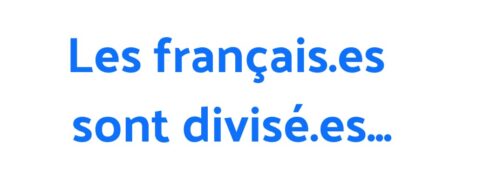Last updated on September 8, 2025
The traditional rule of "masculine prevails over feminine" has long been the dominant tool in our language, but this hasn't always been the case. Inclusive writing is disrupting this balance by offering us a new palette for expressing gender diversity. Each word becomes an opportunity to reflect a more accurate reality, far from mere middle points or complex formulations. This article will shed light on this concept, exploring its origins, objectives, principles, and influence in digital communication. Intended for those seeking to understand linguistic inclusivity or enrich their writing, it will help you better understand the challenges of this practice.
What is inclusive writing?

Definition and example
Inclusive writing, or epicene writing, seeks to balance the representation of women and men in our written communication. This avoids formulas which, often without us thinking about it, put the masculine forward. It goes further by also including all the gender identities. The idea is to build a language that reflects society, without clashing with expressions that erect barriers or propagate stereotypes. Inclusion and parity are at the heart of this approach.
➡️ Example: instead of saying «the teachers prepared the lesson», we could write «the teachers prepared
the course».
➡️ Example: instead of saying «the doctors», inclusive writing offers alternatives like «the medical profession»
or «the medical team».
Who invented inclusive writing?
Inclusive writing was born in the 70s and 80s, carried by the feminist movements and civil rights. It was not the result of a single individual, but of a collective collaboration to make the French language more inclusive. Activists and linguists introduced practices like the midpoint (e.g., "students") to reflect gender diversity. Their goal? To promote equality and fight discrimination. Today, this approach is supported by numerous activist communities and social organizations.

© Cerfia.fr
Who uses inclusive writing?
In France, at the end of 2023, a law restricts inclusive writing in official documents. A real coup! While the ministries and the town halls must put aside inclusive writing for their official publications, the music is not the same elsewhere. Today, some higher education institutions adopt it for educational materials. It is also used by companies engaged in corporate social responsibility (CSR) policies, as well as by various media And websites aimed at promoting inclusivity and reaching a diverse audience. Finally, activist and feminist communities see inclusive writing as a tool to combat discrimination and promote gender equality.
Even though inclusive writing is now banned in some areas, the debate is far from over. In fact, it's still heated, with everyone having strong opinions on the subject.
Why use inclusive writing?
The goal of inclusive writing is to shift the lines in the way we communicate, both orally and in writing, in order to create a bridge to a inclusive society. That's to say :
- Finding a balance : avoid systematically favoring the masculine.
- Making minorities visible : everyone deserves to be seen and heard!
- Raising awareness of non-discrimination : reflect on our linguistic reflexes.
- Breaking the stereotypes : propose alternative forms and avoid masculinization.
- Promoting neutrality in language to avoid gender bias.
- Adapting to societal changes : our world is evolving, and with it, our ways of communicating.
What are the rules of inclusive writing?
Using the midpoint, choosing neutral expressions and alternating genders in examples are all steps towards more inclusive discourse.
The midpoint
THE midpoint is one of the methods used in inclusive writing to include masculine and feminine endings in the same word.
➡️ Example: «the participants» instead of «the participants».
Other alternatives include using a hyphen, parenthesis, or slash.
➡️ Example: «Workshop participants are satisfied with their experience».
➡️ Example: «the engineering students passed their exam».
➡️ Example: «architects are recognized for their creativity».
Epicene words
There epicene formulation favors the use of neutral terms which do not specify gender.
➡️ Example: use «the management» instead of «the directors» or «the directors».
Double flexion
There double flexion includes both masculine and feminine forms in the same sentence or phrase to include both genders.
➡️ Example: say «the directors approved the new regulations» instead of «the directors approved the new regulations».
The agreement of genres
L'gender agreement grants the adjectives and the past participles depending on the genre of the subject.
➡️ Example : «The students are happy.»
The proximity agreement
L'proximity agreement granted the adjective with the closest name.
➡️ Example: «the children and their mother arrived» (agreement with «mother», the closest noun) instead of «the children and their mother arrived».
The use of inclusive pronouns
THE inclusive pronouns offer an option non-binary to include all gender identities in language.
➡️ Example: «iels» can be used instead of «ils» or «elles» to refer to a group without specifying gender.
The feminization of professions, functions and titles
The adaptation of the job titles, of functions and of feminine titles aims to represent the feminine gender in language.
➡️ Example: «engineer» for a woman working in the field of engineering, instead of «engineer».
Alphabetical order
The enumeration of terms feminine And male following alphabetical order.
➡️ Example: «female students» instead of «students and students».
The alternation of genres
L'alternation of genders consists of alternately using the male and the female in examples or sentences for better parity.
➡️ Example: Use "Mr. / Mrs." alternately in a formal letter to show inclusion of both genders.

© blog.hello-bokeh.fr
Inclusive writing on the web
Each of the rules of inclusive writing has advantages and disadvantages in terms of readability, clarity, and aesthetics on the web. The choice of these rules should be guided by:
- your brand identity; ;
- your persona ;
- your digital strategy objectives; ;
- the positioning of your company.
Inclusive writing and digital communication
THE social networks constitute an excellent starting point for testing and adjusting the linguistic approach before extending it to other media such as website, there newsletter and the brochures. This approach allows you to become familiar with inclusive writing, measure its impact, and engage the public in a dialogue about inclusive communication. To do this, consider the following points:
- The analysis continues : Optimize your communication strategy by analyzing social media statistics. This data provides valuable insights into audience engagement and the effectiveness of inclusive writing.
- Feedback from your audience : Regularly ask your subscribers for feedback. Their opinions are invaluable for adapting and improving your inclusive approach. Who better than them to tell you what works for them?
- Training and awareness : Train your editorial and marketing teams in inclusive writing for consistent adoption and to fully understand its benefits.
Inclusive writing and natural referencing (SEO)
Combining SEO and gender-neutral writing is almost an art! Search engine algorithms are getting better at capturing the subtleties of gender-inclusive language, but gender-inclusive terms don't always match the keywords people are searching for. Here's how to integrate gender-inclusive phrases without disrupting your website's organic rankings:
- Body of the text: favor epicene words or double inflection.
- Image descriptions (ALT attribute).
- Calls to action (CTAs).
- Visuals: Incorporate images representing diversity.
- FAQ: Answer questions using inclusive language.
However, it is advisable to use the midpoint sparingly in the title tags (title, H1, H2, H3). Write for humans first, responding to the intention of the Internet user, after for the Google algorithms. Keep your texts clear, relevant and easy to understand for Internet users, because complex content can increase the bounce rate. A welcoming site is designed for the experience user, and this is highly appreciated by the web giant. Use tools like Google Analytics 4, there Search Console to track performance SEO and adjust your content.
An SEO agency can help you optimize your web content, ensuring it's not only inclusive, but also ranks well on search engines like Google, Bing, and Ecosia.
Using artificial intelligence (AI) for inclusive writing
THE advanced language models are valuable allies for integrating inclusive writing into your texts, especially if you have not yet mastered this practice.
For example, you can ask a tool like GPT-4 to rewrite a text using inclusive terms. This makes it easier to adopt this approach in your communications. By using these tools, you save time and ensure communication that is respectful and representative of all identities.
For or against inclusive writing?

Benefits of inclusive writing
Adopting inclusive writing is a step toward equality. Our words have the power to build a space where everyone feels welcome.
For example, when we talk about "female engineer" or "female author," it's our way of recognizing and valuing the presence of women in all professional fields, thus affirming their equal importance to men. And in the world of advertising, media, and marketing? Gender-neutral writing can increase engagement by speaking directly and personally to a wider and more diverse audience.
Additionally, it accommodates cisgender, transgender, and non-binary people by offering language options that fall outside the traditional masculine/feminine framework.
Finally, inclusive writing encourages us to be more creative with words, exploring new ways to express ourselves inclusively.
Disadvantages of inclusive writing
However, this approach to egalitarian writing presents some challenges.
First, there is a question of readability : some find that texts become more complex to "decode." Then, writing and translating texts can prove more difficult. Indeed, the rules for using egalitarian language are not always clear to everyone, leading to questions about the "right" way to use it and, sometimes, confusion.
This uncertainty extends to the field of SEO, where, to date, Google has not issued official guidelines regarding inclusive writing.
Finally, it is not yet welcomed with open arms everywhere, encountering resistance here and there. The French Academy considers it an alteration of our beloved French language.
Towards egalitarian communication?
The goal would be to ensure that inclusive writing truly encompasses everyone fairly. But be careful, it's not about complicating things. Language is our everyday tool. It must remain simple and accessible., including for people with disabilities, language learners or even our elders who perhaps prefer things a little more traditional.
For me, the real challenge is whether it can contribute to a linguistic landscape where everyone feels included, without compromising accessibility of language for all. This topic is a real invitation to reflect and discuss, because it touches on the way we share our thoughts and our lives.
What to remember
Inclusive writing is a much-discussed topic. It aims to adapt existing linguistic conventions to better represent society's diversity. It intrigues, it challenges, and of course, it raises questions: Is it easy to read? Does everyone relate to it? Does it speak to my audience? Does it make our exchanges richer, more open? It's a bit like updating the French language software, asking yourself if everyone is ready for the new version. Some see it as a step forward for inclusivity, while others wonder if it doesn't complicate communication a little too much.
Ultimately, perhaps the important thing is to keep the conversation open, weigh the pros and cons, and see how we can evolve the way we communicate so that no one feels left out. It's a delicate balance between tradition and modernity, between clarity and inclusion.

To go further In your exploration of inclusive language, I invite you to discover the following resources:
- The practical PDF guide "« For public communication without gender stereotypes » : published by the High Council for Equality (HCE) between women and men.
- The manual «Inclusive writing, what if we got started?» by Raphaël Haddad.
- The blog "eninclusif.fr" has a dictionary inclusive collaborative.
- How to do Pinterest keyword research? - October 21, 2025
- Website indexing: how to check and optimize your visibility on Google? - June 10, 2025
- SEO Redirection Plan: Instructions and Tips - June 10, 2025
